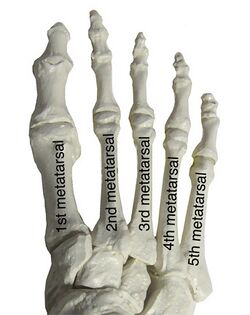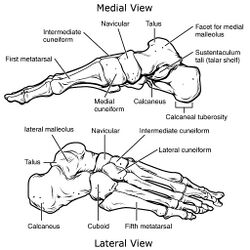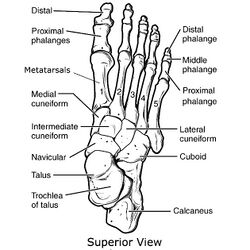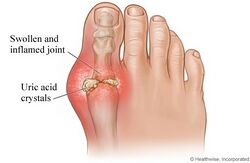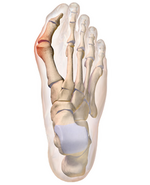Metatarsals: Difference between revisions
No edit summary |
Shejza Mino (talk | contribs) No edit summary |
||
| Line 2: | Line 2: | ||
'''Original Editor '''- [[User:Shejza Mino|Shejza Mino]] | '''Original Editor '''- [[User:Shejza Mino|Shejza Mino]] | ||
'''Top Contributors''' - {{Special:Contributors/{{FULLPAGENAME}}}} | '''Top Contributors''' - {{Special:Contributors/{{FULLPAGENAME}}}} [[File:Metatarsals .jpg|right|frameless|315x315px|alt=]] | ||
== Introduction == | == Introduction == | ||
The metatarsals refer to the five long [[Bone|bones]] found in each [[Foot Anatomy|foot]]. They are numbered I to V, from medial to lateral.<ref name=":1" /> Together, the metatarsal and tarsal bones help to form the main [[Arches of the Foot|arches]] of the foot, which are essential for weight-bearing and [[Gait|walking]]. | The metatarsals refer to the five long [[Bone|bones]] found in each [[Foot Anatomy|foot]]. They are numbered I to V, from medial to lateral.<ref name=":1" /> Together, the metatarsal and tarsal bones help to form the main [[Arches of the Foot|arches]] of the foot, which are essential for weight-bearing and [[Gait|walking]]. | ||
== Gross Anatomy & Structure == | == Gross Anatomy & Structure == | ||
| Line 109: | Line 107: | ||
* Metatarsal stress fractures | * Metatarsal stress fractures | ||
* Neuropathic metatarsal fractures | * Neuropathic metatarsal fractures | ||
'''Gout''' | '''Gout''' | ||
[[File:Gout foot.jpg|right|frameless]] | [[File:Gout foot.jpg|right|frameless|alt=|250x250px]] | ||
[[Gout]] is a form of crystal-induced arthoropathy, formed by monosodium urate monohydrate crystals. The most common joint affected is the metatarsal-phalangeal joint of the big toe.<ref>Rothschild BM. Gout and Pseudogout [Internet]. [https://emedicine.medscape.com/article/329958-overview Practice Essentials, Background, Pathophysiology]. Medscape; 2021 [cited 2021May27]. Available from: <nowiki>https://emedicine.medscape.com/article/329958-overview</nowiki></ref> | [[Gout]] is a form of crystal-induced arthoropathy, formed by monosodium urate monohydrate crystals. The most common joint affected is the metatarsal-phalangeal joint of the big toe.<ref>Rothschild BM. Gout and Pseudogout [Internet]. [https://emedicine.medscape.com/article/329958-overview Practice Essentials, Background, Pathophysiology]. Medscape; 2021 [cited 2021May27]. Available from: <nowiki>https://emedicine.medscape.com/article/329958-overview</nowiki></ref> | ||
'''Hallux valgus'''[[File:Bunion 2.png|frameless|185x185px|alt=|right]][[Hallux Valgus|Hallux vagus]], sometimes referred to as a bunion, refers to malformation of the metatarsalphalangeal (MTP) of the big toe.<ref>Alzurahi A. Bunion Symptom Disorder: Surgical and Non-Surgical Treatment.</ref> See Link | '''Hallux valgus'''[[File:Bunion 2.png|frameless|185x185px|alt=|right]][[Hallux Valgus|Hallux vagus]], sometimes referred to as a bunion, refers to malformation of the metatarsalphalangeal (MTP) of the big toe.<ref>Alzurahi A. Bunion Symptom Disorder: Surgical and Non-Surgical Treatment.</ref> See Link | ||
== References == | == References == | ||
<references /> | <references /> | ||
Revision as of 03:52, 6 July 2021
Original Editor - Shejza Mino
Top Contributors - Shejza Mino, Lucinda hampton, Kim Jackson, Wendy Snyders and Vidya Acharya
Introduction[edit | edit source]
The metatarsals refer to the five long bones found in each foot. They are numbered I to V, from medial to lateral.[1] Together, the metatarsal and tarsal bones help to form the main arches of the foot, which are essential for weight-bearing and walking.
Gross Anatomy & Structure[edit | edit source]
The metatarsal bones run from the tarsus to the phalanges, forming two joints: the tarsometatarsal joint & metatarsolphalangeal joint.[1]
Each metatarsal bone consists of the following:
Articulations[edit | edit source]
Each base of the metatarsal bone articulates with at least one of the tarsal bones, forming the tarsometatarsal joints. The head of the metatarsals articulate with the phalanges, making up the metatarsalphalangeal joints. Additionally, the base of the metatarsals also articulates with the base of the adjacent metatarsal, forming the intermetatarsal joints.[1][2]
The proximal and distal articulations, specific to each metatarsal bone, are listed in the chart below.
| Bone (metatarsal) | Proximal articulation | Distal articulation |
|---|---|---|
| Metatarsal I | medial cuneiform | 1st proximal phalanx |
| Metatarsal II | medial, intermediate & lateral cuneiforms | 2nd proximal phalanx |
| Metatarsal III | lateral cuneiform | 3rd proximal phalanx |
| Metatarsal IV | cuboid | 4th proximal phalanx |
| Metatarsal V | cuboid | 5th proximal phalanx |
Muscular Attachments[edit | edit source]
| Metatarsal | Muscle attachment |
|---|---|
| Metatarsal I | - Base: tibialis anterior, fibularis longus
- Tuberosity: fibularis longus - Lateral shaft: 1st dorsal interosseous |
| Metatarsal II | - Medial shaft: 1st dorsal interosseous
- Lateral shaft: 2nd doral interosseous |
| Metatarsal III | - Medial shaft: 2nd dorsal interosseus & 1st plantar interosseus
- Lateral shaft: 3rd dorsal interosseous |
| Metatarsal IV | - Medial shaft: 3rd dorsal interosseus & 2nd plantar interosseus
- Lateral shaft: 4th dorsal interosseus |
| Metatarsal V | - Medial shaft: 4th dorsal interosseus & 3rd plantar interosseus
- Dorsal base: fibularis tertius - Tuberosity: fibularis brevis - Plantar base: flexor digiti minimi brevis |
Ligaments[edit | edit source]
There are four deep transverse metatarsal ligaments (DTML) that bridge the head of the metatarsal bones. Specifically, they run "between the distal ends of adjacent metatarsal bones and intersect with the plantar ligaments of the metatarsophalangeal joint".[3]
Arches of the Foot[edit | edit source]
The metatarsals contribute significantly to the three arches of the foot. The bones that contribute to each arch are as follows:
- Medial longitudinal arch: talus, calcaneus, navicular, all three cuneiforms and metatarsals 1-3.
- Lateral longitudinal arch: calcaneus, cuboid and metatarsals 4 & 5.
- Transverse arch: bases of all five metatarsals, cuboid and cuneiforms 1-3.[4]
Clinical Significance[edit | edit source]
Metatarsalgia
One of the most prevalent complaints in people with foot disorders is metatarsalgia (metatarsal pain). The pain is limited to the plantar forefoot region, which includes the second through fourth metatarsal heads. However, it is commonly accompanied by toe deformity as well as deformity of the first and fifth rays. There are a variety of proposed causes that are all related to anatomy of the foot, mechanics of gait as well as deformity of the joints related to the ankle and foot.[5]
Fractures
Metatarsal fractures are common foot injuries that are caused by torsion forces or a direct strike. Many of these fractures can be treated successfully with good outcomes. Metatarsal fractures that progress to malunion or nonunion, on the other hand, can cause metatarsalgia or midfoot arthritis. Stress fractures, usually an overuse injury that leads to a thin crack in bone, can also occur in the metatarsals. Stress fractures can also be seen in patients with metabolic bone disease, rheumatoid arthritis.[6] The following is a list of fractures specific to the metatarsals of the foot:
- Dancer’s Fractures (Avulsion fracture of the base of the 5th metatarsal)
- Jones Fractures (5th metadiaphyseal stress fractures)
- Metatarsal base fractures and Lisfranc injuries
- Metatarsal stress fractures
- Neuropathic metatarsal fractures
Gout
Gout is a form of crystal-induced arthoropathy, formed by monosodium urate monohydrate crystals. The most common joint affected is the metatarsal-phalangeal joint of the big toe.[7]
Hallux valgus
Hallux vagus, sometimes referred to as a bunion, refers to malformation of the metatarsalphalangeal (MTP) of the big toe.[8] See Link
References[edit | edit source]
- ↑ 1.0 1.1 1.2 1.3 Moore KL, Dalley AF. Clinically oriented anatomy. Wolters kluwer india Pvt Ltd; 2018 Jul 12.
- ↑ 2.0 2.1 Chummy SS. Last’s Anatomy: Regional and Applied. Churchill Livingstone.
- ↑ Abdalbary SA, Elshaarawy EA, Khalid BE. Tensile properties of the deep transverse metatarsal ligament in hallux valgus: a CONSORT-compliant article. Medicine. 2016 Feb;95(8).
- ↑ Babu D, Bordoni B. Anatomy, Bony Pelvis and Lower Limb, Medial Longitudinal Arch of the Foot. StatPearls [Internet]. 2020 Sep 1.
- ↑ Espinosa N, Brodsky JW, Maceira E. Metatarsalgia. JAAOS-Journal of the American Academy of Orthopaedic Surgeons. 2010 Aug 1;18(8):474-85.
- ↑ Cothran VE. Metatarsal Stress Fracture. Medscape 2019. https://emedicine.medscape.com/article/85746-overview (accessed May 29, 2021).
- ↑ Rothschild BM. Gout and Pseudogout [Internet]. Practice Essentials, Background, Pathophysiology. Medscape; 2021 [cited 2021May27]. Available from: https://emedicine.medscape.com/article/329958-overview
- ↑ Alzurahi A. Bunion Symptom Disorder: Surgical and Non-Surgical Treatment.
